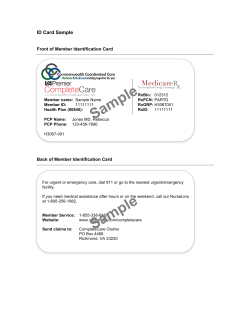
Lombardy case: Hospital of Niguarda - Sara Bedin
The case at a glance The Lombardy Region innovation procurement pilot Amount of resources allocated: 750K EUR Source of funding: Lombardy Region own R&D budget Intensity of funding: (100% PCP) – (100% PPI) Procurer/Recipients of innovation: Lombardy Region (General Direction for Healthcare) + Niguarda Hospital (and others local hospitals) Policy maker: Lombardy Region (Direction for research) Adjudicating authority: ARCA (Regional Purchasing Agency) Implementing act: • Agreement ex art.15 L.241 • Public notice for open technical dialogue and public hearing • Public notice for explorative survey • Call for tender publicated in the Official Gazette of the EU + Official Gazette of the Republic of Italy + website + newspapers on 08/03/2013. Who is/are the procuring Authority/ies Commitment at all levels and involvement of public entities representing the real demand side: • √ √ that are responsible for the acquisition strategy of the new solutions that could be developed as a result of the PCP • that can mobilise, besides public procurement, the most important demand side instruments to speed up market introduction of solutions. • or that participate in public service delivery chain and/or Lombardy Region • General Direction for Healthcare • General Direction for Research • ARCA Niguarda Hospital • Clinical Engineering Department • Medical Direction Department • Quality and clinical safety Department • Direction of nursing The Project’s business case The problem: • high rate of accidents and collateral effects of sociohealth workers tasked with moving, via manual pushing and pulling, the hospital beds; • long transport times The desidered solution: • Automated universal medical device for moving hospital beds which result in a significant advance in terms of technology and performance and, at the same time, cost reduction. The expected impact: enhance the service productivity and reduce the negative impact on the cost of the public services offered • improve patient comfort and safety when moved, • avoid collateral and unwanted effect affecting nursing personnel and socio-health operators, • less personnel need and more efficient socio-health workers allocation, generally below strength for the needs, • reduction (at least 20%) in the cost of the solution. The end-to-end process The step-wise procedure adopted Key point #1 ...CREDIBILITY & CONCRETENESS... starting from a «genuine» demand and making a «truthful» business case 7 To determine a “credible” PCP... i. Promote cross-organizational coordination and bundle the public demand to create a critical mass to acquire cost-effective and innovative solutions and to predetermine the condition for the development of new, domain related, EU standard. ii. Involve users in specification of requirements in order to increase acceptance of new solution (especially where behavioural change is required). iii. Make a business case to evaluate the potential absorptive capacity of market for diffusion (no uniqueness or tailored features). Key point #2 ...REDUCE INFORMATION ASYMMETRIES... understanding the SoA and the on-going developments to evaluate the innovation gap 9 To reduce information asymmetries... i. Enable the industrial sector’s awareness about the real need, inviting competitors to carry out an early inspections of test bed and putting in place the testing & experimentation arrangements. ii. Enable the innovation gap in a way that not distort or preclude the competition iii. Involve users during the design process and piloting in order to reduce the asymmetry in capabilities, information and knowledge and also to test the validity of their assumptions. Key point #3 ...STIMULATE COMPETITION and PREVENT future LOCK-IN extending the realization of efficiency and effectiveness gains also over longer the contract period To stimulate competition and prevent (future) lock-in... i. Define the need for innovation in terms of functional and performance requirement, classified according to the product life-cycle. ii. Use forward looking criteria and not stringent qualification requirements as in procurements for large scale deployment. iii. Assign IPRs to companies and foster contractually the exploitation and commercialization of results in a given period of time For further information www.inspirecampus.eu
© Copyright 2025











